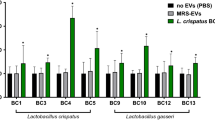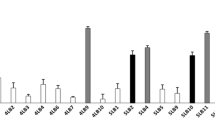Abstract
Lactobacillus iners is prominent in the human vagina and is able to persist despite development of bacterial vaginosis and treatment with antibiotics. A probable factor in its persistent survival is its ability to be retained in the vaginal epithelia. Genome sequencing of the strain showed an organism deplete of many metabolic pathways, yet equipped with fibronectin (Fn)-binding adhesins. The objective of the present study was to assess the ability of L iners AB-1 to bind immobilized Fn. Results showed that the organism superiorly bound the protein compared to other species of Lactobacillus and known binders such as Staphylococcus aureus. Treatment of L iners cells by protease rendered its binding abilities to Fn nonfunctional. The findings indicate a mechanism of vaginal persistence for a Lactobacillus species, with implications for reproductive health.
Similar content being viewed by others
References
Fredricks DN, Fiedler TL, Marrazzo JM. Molecular identification of bacteria associated with bacterial vaginosis. N Engl J Med. 2005;353(18):1899–1911.
Hummelen R, Fernandes AD, Macklaim JM, et al. Deep sequencing of the vaginal microbiota of women with HIV. PLoS One. 2010;5(8):e12078.
Ravel J, Gajer P, Abdo Z, et al. Vaginal microbiome of reproductive-age women. Proc Natl Acad Sci U S A. 2011; 108(suppl 1):4680–4687.
Tamrakar R, Yamada T, Furuta I, et al. Association between Lactobacillus species and bacterial vaginosis-related bacteria, and bacterial vaginosis scores in pregnant Japanese women. BMC Infect Dis. 2007;7:128.
Donders GG, Vereecken A, Bosmans E, Dekeersmaecker A, Salembier G, Spitz B. Definition of a type of abnormal vaginal flora that is distinct from bacterial vaginosis: aerobic vaginitis. BJOG. 2002;109(1):34–43.
Cadieux PA, Burton J, Devillard E, Reid G. Lactobacillus by-products inhibit the growth and virulence of uropathogenic Escherichia coli. J Physiol Pharmacol. 2009;60(suppl 6):13–18.
Sharami SH, Afrakhteh M, Shakiba M. Urinary tract infections in pregnant women with bacterial vaginosis. J Obstet Gynaecol. 2007;27(3):252–254.
Burton JP, Cadieux PA, Reid G. Improved understanding of the bacterial vaginal microbiota of women before and after probiotic instillation. Appl Environ Microbiol. 2003;69(1):97–101.
Sobel JD. Bacterial vaginosis. Annu Rev Med. 2000;51:349–356.
Zhou X, Hansmann MA, Davis CC, et al. The vaginal bacterial communities of Japanese women resemble those of women in other racial groups. FEMS Immunol Med Microbiol. 2010; 58(2):169–181.
Saunders S, Bocking A, Challis J, Reid G. Effect of Lactobacillus challenge on Gardnerella vaginalis biofilms. Colloids Surf B Biointerfaces. 2007;55(2):138–142.
Yan DH, Lu Z, Su JR. Comparison of main Lactobacillus species between healthy women and women with bacterial vaginosis. Chin Med J (Engl). 2009;122(22):2748–2751.
Velez MP, De Keersmaecker SC, Vanderleyden J. Adherence factors of Lactobacillus in the human gastrointestinal tract. FEMS Microbiol Lett. 2007;276(2):140–148.
Irvine SL, Hummelen R, Hekmat S, Looman CW, Habbema JD, Reid G. Probiotic yogurt consumption is associated with an increase of CD4 count among people living with HIV/AIDS. J Clin Gastroenterol. 2010;44(9):e201–e205.
Macklaim JM, Gloor GB, Anukam KC, Cribby S, Reid G. At the crossroads of vaginal health and disease, the genome sequence of Lactobacillus iners AB-1. Proc Natl Acad Sci U S A. 2011; 108(suppl 1):4688–4695.
Sinha B, Francois PP, Nusse O, et al. Fibronectin-binding protein acts as Staphylococcus aureus invasin via fibronectin bridging to integrin alpha5beta1. Cell Microbiol. 1999;1(2):101–117.
Reid G, Cook RL, Bruce AW. Examination of strains of lactobacilli for properties that may influence bacterial interference in the urinary tract. J Urol. 1987;138(2):330–335.
Silva M, Jacobus NV, Deneke C, Gorbach SL. Antimicrobial substance from a human Lactobacillus strain. Antimicrob Agents Chemother. 1987;31(8):1231–1233.
Skerman VB. Approved list of bacterial names. Int J Syst Bacteriol. 1980;30:225–420.
Schlievert PM, Blomster DA. Production of staphylococcal pyrogenic exotoxin type C: influence of physical and chemical factors. J Infect Dis. 1983;147(2):236–242.
Munoz-Provencio D, Perez-Martinez G, Monedero V. Characterization of a fibronectin-binding protein from Lactobacillus casei BL23. J Appl Microbiol. 2010;108(3): 1050–1059.
Antonas K, Yajko D, Hardley W. Assay of fibronectin in vaginal fluid and the role of fibronectin in bacterial colonization. Annual Meeting of the American Society of Microbiology. 1983: Abstract no. 1310.
Martinez RC, Franceschini SA, Patta MC, et al. Improved cure of bacterial vaginosis with single dose of tinidazole (2 g), Lactobacillus rhamnosus GR-1, and Lactobacillus reuteri RC-14: a randomized, double-blind, placebo-controlled trial. Can J Microbiol. 2009;55(2):133–138.
Reid G, Charbonneau D, Erb J, et al. Oral use of Lactobacillus rhamnosus GR-1 and L. fermentum RC-14 significantly alters vaginal flora: randomized, placebo-controlled trial in 64 healthy women. FEMS Immunol Med Microbiol. 2003;35(2):131–134.
Dutta D, Norman JE. The efficacy of fetal fibronectin testing in minimising hospital admissions, length of hospital stay and cost savings in women presenting with symptoms of pre-term labour. J Obstet Gynaecol. 2010;30(8):768–773.
Antonio MA, Meyn LA, Murray PJ, Busse B, Hillier SL. Vaginal colonization by probiotic Lactobacillus crispatus CTV-05 is decreased by sexual activity and endogenous lactobacilli. J Infect Dis. 2009;199(10):1506–1513.
Younes JA, van der Mei HC, van den Heuvel E, Busscher HJ, Reid G. Adhesion forces and coaggregation between vaginal staphylococci and lactobacilli. PLoS One. 2012;7(5):e36917.
Nagy E, Froman G, Mardh PA. Fibronectin binding of Lactobacillus species isolated from women with and without bacterial vaginosis. J Med Microbiol. 1992;37(1):38–42.
Pusch O, Kalyanaraman R, Tucker LD, Wells JM, Ramratnam B, Boden D. An anti-HIV microbicide engineered in commensal bacteria: secretion of HIV-1 fusion inhibitors by lactobacilli. AIDS. 2006;20(15):1917–1922.
Liu JJ, Reid G, Jiang Y, Turner MS, Tsai CC. Activity of HIV entry and fusion inhibitors expressed by the human vaginal colonizing probiotic Lactobacillus reuteri RC-14. Cell Microbiol. 2007;9(1):120–130.
Alderete JF, Benchimol M, Lehker MW, Crouch ML. The complex fibronectin—Trichomonas vaginalis interactions and trichomonosis. Parasitol Int. 2002;51(3):285–292.
Author information
Authors and Affiliations
Corresponding author
Rights and permissions
About this article
Cite this article
McMillan, A., Macklaim, J.M., Burton, J.P. et al. Adhesion of Lactobacillus iners AB-1 to Human Fibronectin: A Key Mediator for Persistence in the Vagina?. Reprod. Sci. 20, 791–796 (2013). https://doi.org/10.1177/1933719112466306
Published:
Issue Date:
DOI: https://doi.org/10.1177/1933719112466306




